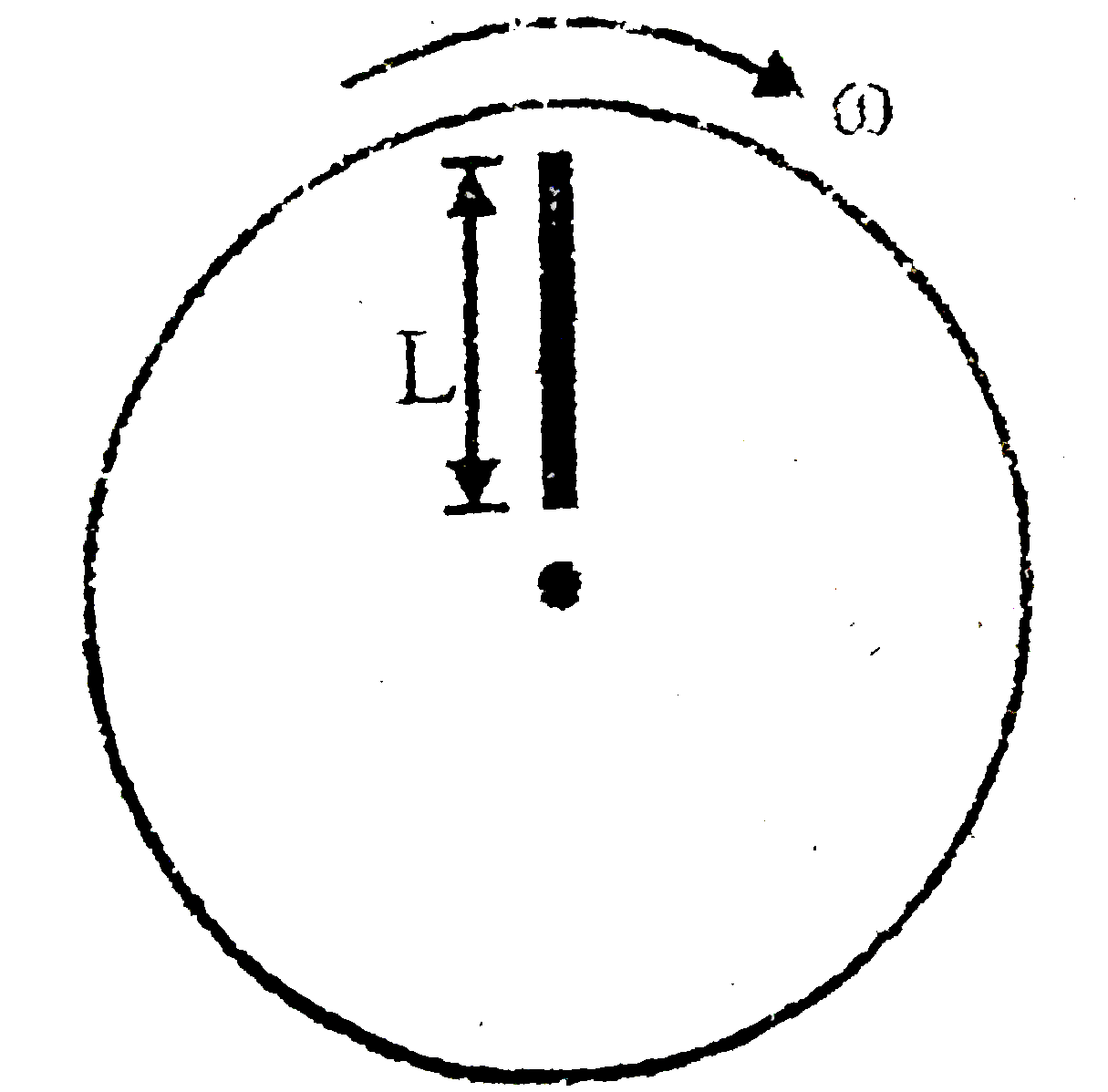A disc of radius R rotates with constant angular velocity ω about its own axis. Surface charge density of this disc varies as σ=αr2, where r is the distance from the centre of disc. Determine the magnetic field intensity at the centre of disc.
μ0αωR3
μ0αωR36
μ0αωR38
μ0αωR33
The correct Answer is:B
To determine the magnetic field intensity at the center of a rotating disc with a given surface charge density, we can follow these steps:
1. Understand the Problem: We have a disc of radius R rotating with a constant angular velocity ω. The surface charge density varies as σ=αr2, where r is the distance from the center of the disc.
2. Consider a Differential Element: To find the magnetic field at the center, we can consider a thin ring of radius r and thickness dr on the disc. The area of this ring is dA=2πrdr.
3. Calculate the Charge on the Ring: The charge dq on this ring can be calculated using the surface charge density:
dq=σ⋅dA=αr2⋅(2πrdr)=2παr3dr
4. Determine the Current Due to Rotation: The ring rotates with angular velocity ω, which means it behaves like a current loop. The current i due to the charge dq can be expressed as:
i=dqT
where T is the time period for one complete rotation. The time period T is given by:
T=2πω
Therefore,
i=dqT=2παr3dr2πω=αωr3dr
5. Calculate the Magnetic Field Contribution from the Ring: The magnetic field dB at the center of the disc due to the current i in the ring is given by the formula:
dB=μ0i2r
Substituting for i:
dB=μ0(αωr3dr)2r=μ0αωr22dr
6. Integrate to Find Total Magnetic Field: To find the total magnetic field B at the center of the disc, integrate dB from r=0 to r=R:
B=∫R0dB=∫R0μ0αωr22dr
This integral evaluates to:
B=μ0αω2∫R0r2dr=μ0αω2(r33)R0=μ0αω2⋅R33
Simplifying gives:
B=μ0αωR36
7. Final Result: The magnetic field intensity at the center of the disc is:
B=μ0αωR36
dq=σ⋅dA=αr2⋅(2πrdr)=2παr3dr
i=dqT
where T is the time period for one complete rotation. The time period T is given by:
T=2πω
Therefore,
i=dqT=2παr3dr2πω=αωr3dr
dB=μ0i2r
Substituting for i:
dB=μ0(αωr3dr)2r=μ0αωr22dr
B=∫R0dB=∫R0μ0αωr22dr
This integral evaluates to:
B=μ0αω2∫R0r2dr=μ0αω2(r33)R0=μ0αω2⋅R33
Simplifying gives:
B=μ0αωR36
B=μ0αωR36
Topper's Solved these Questions
- MAGNETIC FIELD AND FORCESBook:DC PANDEYChapter:MAGNETIC FIELD AND FORCESExercise:Assertion and reason
Explore 20 Videos
- MAGNETIC FIELD AND FORCESBook:DC PANDEYChapter:MAGNETIC FIELD AND FORCESExercise:Match the following
Explore 4 Videos
- MAGNETIC FIELD AND FORCESBook:DC PANDEYChapter:MAGNETIC FIELD AND FORCESExercise:Check point
Explore 54 Videos
- INTERFERENCE AND DIFFRACTION OF LIGHTBook:DC PANDEYChapter:INTERFERENCE AND DIFFRACTION OF LIGHTExercise:Level 2 Subjective
Explore 5 Videos
- MAGNETICSBook:DC PANDEYChapter:MAGNETICSExercise:MCQ_TYPE
Explore 1 Video
Similar Questions
A metal disc of radius R rotates with an angular velcoity ω about an axis perpendicular to its plane passing through its centre in a magnetic field B acting perpendicular to the plane of the disc. Calculate the induced emf between the rim and the axis of the disc.
View SolutionA uniformly charged disc of radius r and having charge q rotates with constant angular velocity ω. The magnetic dipole moment of this disc is 1nqωr2. Find the value of n.
View Solution
Knowledge Check
A heavy disc is rotating with uniform angular velocity ω about its own axis. A piece of wax sticks to it. The angular velocity of the disc will
AincreaseBdecreaseCbecomes zeroDremain unchangedA metal disc of radius a rotates with a constant angular velocity ω about its axis. The potential difference between the center and the rim of the disc is (m = mass of electron, e = charge on electro)
Amω2a2eB12mω2a2eC( c) eω2a22mDeω2a2mA uniform rod of mass m and length L lies radialy on a disc rotating with angular speed ω in a horizontal plane about vertical axis passing thorugh centre of disc. The rod does not slip on the disc and the centre of the rod is at a distance 2L from the centre of the disc. them the kinetic energy of the rod is
 A49mL2ω224B2mω2L2C124mω2L2D13mL2ω224
A49mL2ω224B2mω2L2C124mω2L2D13mL2ω224
A disc of radius R rotates at an angular velocity ω about the axis perpendicular to its surface and passing through its centre. If the disc has a uniform surface charge density σ, find the magnetic induction on the axis of rotation at a distance x from the centre. (Given R=3m, x=4m and μ0σω=20Tesla/m.)
View SolutionA conducting disc of radius r rotates with a small but constant angular velocity ω about its axis. A uniform magnetic field B exists parallel to the axis of rotation. Find the motional emf between the centre and the periphery of the disc.
View Solutiona conducting disc of radius R roatates about its axis when an angular velocity ω.Then the potential difference between the centre of the disc and its edge is (no magnetic field is present ):
View SolutionA uniform disc is rotating at a constant speed in a vertical plane about a fixed horizontal axis, passing through the centre of the disc. A piece of disc from its rim detaches itself from the disc at the instant when it is, on the same horizontal with the centre of the disc and moving upwards. lien about the fixed axis, the angular speed of the
View SolutionA circular copper disc of radius 25 cm is rotating about its own axis with a constant angular velocity of 130rad/s . If a magnetic field of 5×10−3 Tesla is applied at right angles to the disc, then the induced potential difference between the centre and the rim of the disc will approximately be __
View Solution

